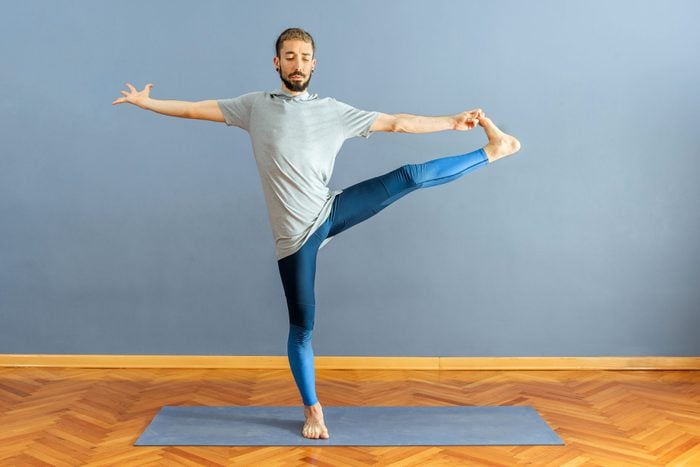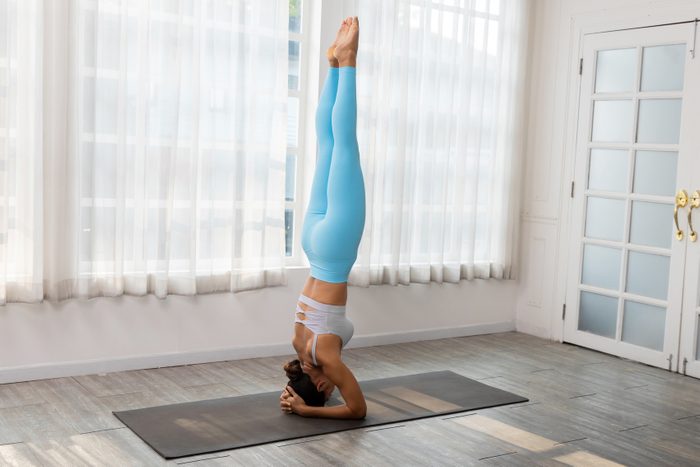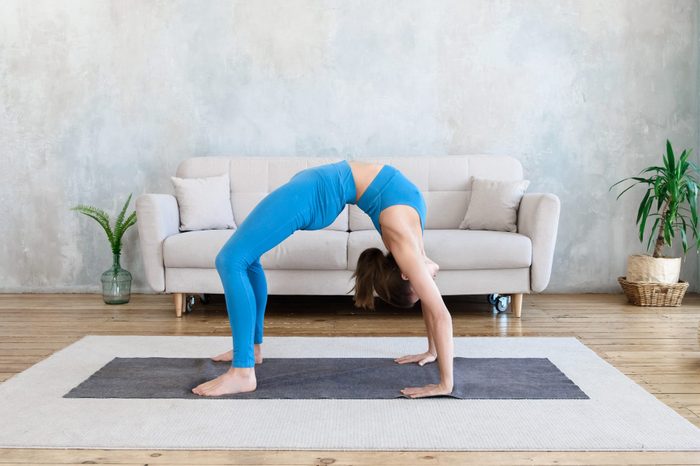
When you experience digestive issues, you might try pretty much anything for relief—whether it’s a specific diet, cutting down on dairy or maybe taking some probiotics. There are a lot of ways you can work to ease discomfort and get things moving more regularly. Exercise, for example, can offer a lot of relief; in fact, a 2015 peer-reviewed study in the journal Evidence-based Complementary and Alternative Medicine even found that yoga can help people manage the primary and secondary symptoms of irritable bowel syndrome (IBS).
To learn more, The Healthy @Reader’s Digest spoke with YogaRenew Teacher Training instructor Lindsay Monal, RYT (also a reiki master teacher), about which yoga poses you can incorporate in your routine to improve your gut health.
A Bone Health Doctor Just Listed the 12 Best Yoga Poses to Strengthen Bones

Big Toe Pose II (padangustasana)
“This posture is geared toward regulating the kidney meridian,” Monal says. “The kidneys are a vital organ for containing and filtering blood, and when regulated properly contribute to our overall energy levels.” We sure like the sound of that.
Monal adds that you can try this pose standing, or lying down. If you lie down while you do it, Monal suggests you “place a blanket, bolster or block beneath the lifted leg to support the lengthening of the inner leg from the inner arch of the foot, to the inner knee, to the inner groin.” She adds: “Your inhales and exhales should be sent toward the location of your kidneys in the lower back region, just below the diaphragm.”
Here’s How Much Protein You Really Need in a Day, with a Kidney Doctor’s Wisdom

Supported Headstand (Salamba Sirsasana A)
Monal recommends trying inversions, such as a headstand, for gut relief. She says they provide an “anti-gravity effect” to your organs and surrounding tissues, which can offer “physiological support and benefits for one’s visceral organs.” (The visceral organs are the body’s soft organs, such as the heart, lungs, and liver. Most visceral organs are housed within the body’s core—that is, the chest and abdomen.)
A Gastroenterologist’s Surprising Recommended Way to Relieve Constipation

Full Wheel (Urdhva Dhanurasana)
Monal says that when it’s done right, the full wheel pose creates space for something called motility, when organs can move around and slide along one another. “Deep backbends help to lengthen the tissues and muscles which surround the gut,” Monal says, adding that “it is helpful to stretch the walls of the abdominal region which house the internal organs.”
Here’s How Long You Should Hold a Yoga Pose, Says a 50-Year Yogi (Who’s Also a Bone Doctor)

Supine Twist
“Similar to backbends, twists can contribute to yoking the organs of the gut to achieve an optimal state of motility,” Monal says. “Proper gut health also aids in efficient absorption and digestion of food and nutrients.”
Monal notes that you should twist toward the right first, followed by the left, as this follows the direction of digestion through your intestines. Also important is understanding right from left in yoga twisting poses: “Always think about which way your belly is turning, not where your knees are going.”

Child’s Pose
“Once the organs have space to move around, doing the opposite…compressing or squeezing the organs (in an intentional manner) and then letting it go has positive effects in allowing optimal circulation through the gut,” Monal says. “It’s like a cleansing and purifying process through churning of the visceral organs.” (Sounds kind of amazing, doesn’t it?)
She adds that you can also try variations of child’s pose targeted to compress the viscera, including putting your knees together or placing your fists or a rolled blanket into the front of the abdomen, just below the naval. “Deep breathing sent into the abdomen and lower back should accompany this practice,” Monal says.
6 Breathing Mistakes You’re Making—And How to Breathe Better

Practicing yoga for gut health
No one yoga move is going to be a quick fix for digestive issues. Mondal says to keep in mind that these poses “should be done consistently in practice, not just when you are experiencing gut distress.” And even if you don’t suffer with a chronic issue like IBS, Mondal emphasizes that “proper gut health isn’t only for those who experience gut distress—it really is for everyone on a regular basis.”
For more wellness updates, follow The Healthy on Facebook, Instagram, and Twitter. Keep reading:

